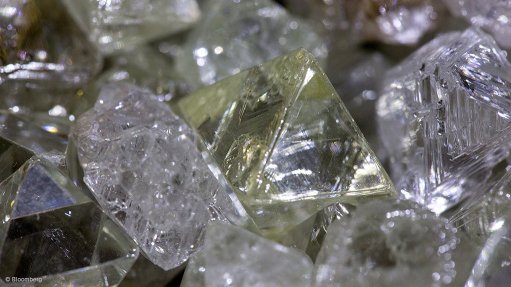
Photo by: Bloomberg
JOHANNESBURG (miningweekly.com) – Diversified mining giant Rio Tinto on Thursday vowed to “sustainably” increase cash returns to shareholders from next year, and for decades to come.
Despite a challenging near-term outlook, the company’s Tier 1 assets, a relentless focus on financial discipline, improved earnings before interest, taxes, depreciation and amortisation (Ebitda) margins, the quality and longevity of resources and reserves and its potential for expansion and growth supported a journey towards healthy free cash flow and shareholder returns.
“There is no question our world-class assets will generate sustainable returns for decades to come,” Rio CEO Sam Walsh said during an investor seminar in London this week, adding that every dollar spent must be allocated in the interest of the shareholders.
“There is a clear focus behind everything we are doing,” he noted, pointing out that uncertainty played to Rio’s strengths, while its “competitive advantages” emerged during challenging environments.
Updating investors on the company’s financial performance during the year, Walsh explained that Rio’s total capital expenditure during 2014 fell 34% year-on-year and was below the $8.5-billion forecast, while operating and exploration costs were cut by $5.4-billion since 2012.
Rio had achieved its mid-teens debt target and was now adopting a net gearing ratio-based target range of 20% to 30% to protect investors and provide flexibility.
The mining major also completed $3.5-billion divestments since 2013, reiterating a disciplined allocation of capital to the highest returning projects.
ALUMINIUM
Rio was currently improving its bauxite assets and first-quartile smelting position through the recommissioning of Kitimat, in British Columbia, Canada, next year, which would result in 80% of Rio Tinto smelters falling into the first quartile of the aluminium cost curve.
“The bauxite export business is expected to deliver Ebitda margins greater than 50% at consensus 2014 to 2019 prices,” Walsh added.
Further, prioritisation had been given to the South of Embley project, in Queensland, Australia, for which a feasibility study was in progress.
Rio eyed first production from Embley in 2018, and would seek board approval for the project next year.
COPPER
The group’s copper business was focused on driving profitability, reducing costs and enhancing productivity to drive earnings and move the business down the cost curve.
The business, which expected an average compound copper equivalent growth of more than 5% between 2013 and 2019, was preparing to “exploit the next copper market cycle” by bringing additional copper units online and progressing its pipeline of greenfield projects, including La Granja, in north-east Peru, and Resolution, in Arizona, US.
“Rio Tinto copper is positioning itself as a low-cost producer in the short and medium term, building a business model that creates value through the economic cycles and sets it on a pathway to be the most profitable business in the industry,” Walsh commented.
DIAMONDS
Rio also planned to increase the margins of its diamonds and minerals operations’ in line with growing demand fuelled by the emergence of the middle class in China and other developing economies.
“The diverse portfolio is delivering value for shareholders by streamlining and simplifying the businesses which, in turn, is having a real impact on cash-flow generation.”
IRON-ORE
Walsh highlighted the “compelling investment fundamentals” for the expansion of Rio Tinto’s iron-ore operations in the Pilbara region of Australia, which was now in “full swing” and delivering an average mine production capital intensity of around $9/t.
“[The] Pilbara iron-ore operations remain the envy of the sector. [The] expansion [will lead] to [output of] 360-million tonnes a year, [with] a 40% internal rate of return and a five-year payback period,” he pointed out.